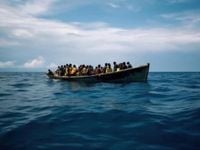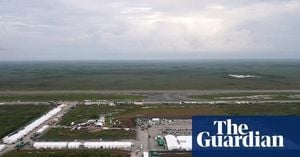Off the windswept coast of Mauritania, tragedy struck again this week as a vessel packed with hopeful migrants capsized, claiming the lives of at least 70 people in one of the deadliest incidents along the perilous Atlantic migration route in recent memory. The accident, which occurred late Tuesday night on August 26, 2025, has left families in Gambia, Senegal, and beyond reeling, and put a harsh spotlight on the dangers faced by those desperate enough to risk everything for a shot at a better life in Europe.
According to Gambia’s foreign affairs ministry, the ill-fated boat is believed to have departed from Gambia about a week before the disaster, carrying mostly Gambian and Senegalese nationals. Initial reports had put the death toll at 49, but as Mauritanian authorities continued their grim recovery efforts on Wednesday and Thursday, the tally rose to 70. Witness accounts gathered by officials and reported by various outlets, including AFP, suggest the true number of fatalities may climb even higher, with some estimating over 100 lives lost.
The circumstances leading up to the capsizing were as tragic as they were sudden. A senior Mauritanian coast guard official told AFP that the migrants, after days at sea, spotted the lights of a town about 80 kilometers north of the capital, Nouakchott. In a moment of collective hope or desperation, many rushed to one side of the vessel, causing it to tip and ultimately capsize. The official added, "One of the coast guard's patrols had been able to rescue 17 people." The survivors, battered and traumatized, were pulled from the Atlantic’s unforgiving waters as recovery teams worked tirelessly to retrieve the bodies of the dead.
Estimates of the boat’s original passenger list vary slightly, but both the Gambian foreign ministry and Mauritanian coast guard agree the vessel was dangerously overloaded, carrying somewhere between 150 and 160 people. The vast majority were from Gambia and Senegal, two West African nations where economic hardship and limited prospects have driven many to undertake the hazardous journey northward.
Officials did not specify the intended destination of the migrants, but the route they took is a well-known one: the Atlantic corridor from West Africa to Spain’s Canary Islands. This stretch of open ocean has become a notorious graveyard for those fleeing poverty, conflict, or persecution in search of safety and opportunity in Europe. According to the European Union, more than 46,000 irregular migrants successfully reached the Canary Islands in 2024—a record high. But the journey is fraught with danger: the Spanish NGO Caminando Fronteras estimates that at least 10,457 people died or went missing at sea that same year, a staggering 58% increase over the previous year.
For those who survive the crossing, the ordeal is far from over. Human Rights Watch (HRW) released a damning 142-page report last Wednesday detailing a litany of abuses suffered by West and Central African migrants at the hands of Mauritanian security forces between 2020 and early 2025. The report, based on dozens of interviews and first-hand accounts, describes a grim pattern of violence and neglect: torture, rape, arbitrary arrests and detention, inhumane conditions, racist treatment, extortion, theft, and summary expulsions. Many migrants recounted being held in police-run detention centers where food was scarce, sanitation was almost nonexistent, and dignity was in short supply.
According to HRW, "Between 2020 and mid-2025, Mauritanian police expelled tens of thousands of African foreigners of multiple nationalities to remote locations along the borders with Mali and Senegal, where limited aid, plus worsening insecurity in Mali’s Kayes region, has put people at risk." These expulsions often left migrants stranded in dangerous border zones, cut off from assistance and exposed to further harm.
The situation is further complicated by the role of the European Union and Spain, which have for years supported Mauritania’s border and migration control authorities. Rights groups argue that this outsourcing of migration management has not only failed to stem the tide of dangerous crossings but has also contributed to a climate of impunity for abuses committed by local security forces. The European Union’s efforts, intended to curb irregular migration at its source, have instead been linked to a rise in crackdowns and rights violations along West Africa’s Atlantic coast.
Sadly, this week’s disaster is not an isolated incident. In July 2024, more than a dozen migrants died and 150 were declared missing off the same Mauritanian coast. The pattern is chillingly familiar: overcrowded, unseaworthy boats; desperate passengers; and a journey that too often ends in catastrophe. Drownings are frequent, as strong ocean currents and ramshackle vessels make the crossing between Africa and Europe particularly treacherous.
In the aftermath of the latest tragedy, Gambia’s foreign affairs ministry issued a heartfelt plea to its citizens: "We implore our nationals to refrain from embarking on such perilous journeys, which continue to claim the lives of many." It’s a message echoed by officials and advocates across the region, but one that struggles to compete with the powerful forces driving migration—poverty, instability, and the relentless hope for a better future.
The response from authorities has been a mix of rescue, recovery, and investigation. Mauritanian coast guard patrols worked through the night and into the following days, pulling survivors from the sea and retrieving bodies. The exact number of people still missing remains unclear, but with only 16 or 17 confirmed rescued out of an estimated 150 to 160 passengers, the death toll is almost certain to rise.
For families back in Gambia, Senegal, and elsewhere, the agony of uncertainty is compounded by the lack of information and the slow, painful process of identification and repatriation. Many will wait days or weeks for news, clinging to hope even as the odds grow longer with each passing hour.
The broader context is one of crisis and contradiction. On the one hand, European governments and their West African counterparts have ramped up efforts to police borders and stem the flow of migrants. On the other, the underlying causes of migration—economic hardship, lack of opportunity, and insecurity—remain stubbornly unaddressed. The result is a deadly stalemate, with migrants caught in the middle, risking everything for a chance at a new life.
As the world absorbs the news of yet another mass drowning off the West African coast, the question lingers: how many more lives must be lost before meaningful change takes hold? For now, the Atlantic route remains one of the world’s deadliest, and the dreams of those who set out in search of hope too often end in tragedy.




